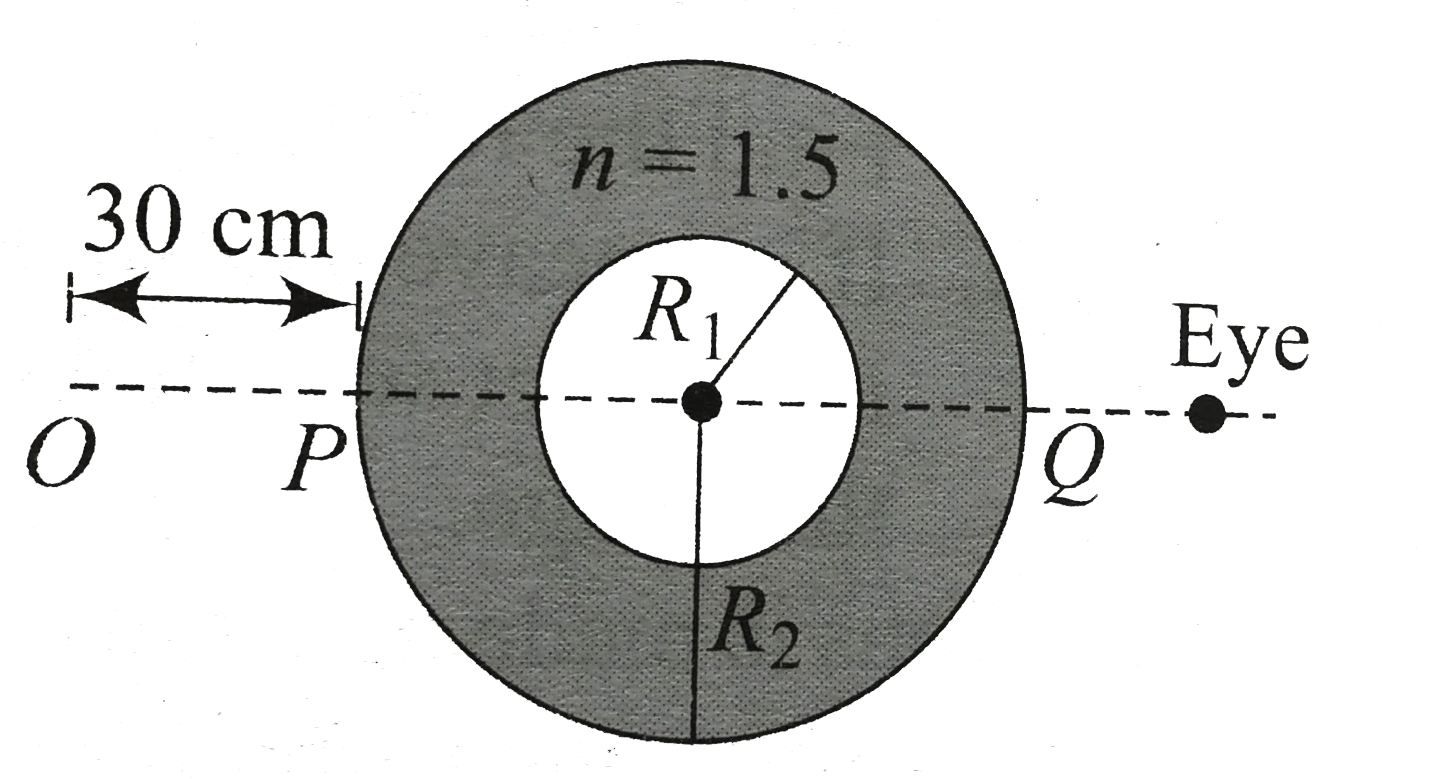The n transparent slabs of refractive index1.5 each having thickness 1cm, 2 cm,…to n cm are arranged one over another. A point object is seen through this combineation with near perpendicular light. If the shift of object by the combination is 1 cm, then find the value of n.
x=total shift
x=x1+x2+…+xn
=t1(1−1μ)+t2(1−1μ)+...+tn(1−1μ)
or 1cm=(1−23)1+2+3+…+n
1=n(n+1)6
6=n(n+1)⇒n=2
Topper's Solved these Questions
- GEOMETRICAL OPTICSBOOK - CENGAGE PHYSICSCHAPTER - GEOMETRICAL OPTICSEXERCISE - Exercise1.4
12 Videos
- GEOMETRICAL OPTICSBOOK - CENGAGE PHYSICSCHAPTER - GEOMETRICAL OPTICSEXERCISE - Exercise1.5
22 Videos
- GEOMETRICAL OPTICSBOOK - CENGAGE PHYSICSCHAPTER - GEOMETRICAL OPTICSEXERCISE - Exercise1.2
20 Videos
- FRICTIONBOOK - CENGAGE PHYSICSCHAPTER - FRICTIONEXERCISE - QUESTION BANK
1 Videos
- GRAVITATIONBOOK - CENGAGE PHYSICSCHAPTER - GRAVITATIONEXERCISE - Question Bank
39 Videos
Similar Questions
k transparent slabs are arranged one over another. The refractive indices of the slabs are μ1,μ2,μ3,.............μk and the thicknesses are t1,t2,t3.............,tk . An object is seen through this combination with nearly perpendicular light. Find the equivalent refractive index of the system which will allow the image to be formed at the same place.
View SolutionThere is a spherical glass shell of refractive index 1.5, inner radius 10 cm and outer radius 20 cm. Inside th espherical cavity, there is air. A point object is placed at a point O at a distance of 30cm from the outer spherical surface. Find the final position of th eimage as seen eye.

View Solution
Knowledge Check
An object is placed 21 cm in front of a concave mirror of radius of curvature 10cm. A glass slab of thickness 3cm and refractive index 1.5 is then placed close to the error in the space between the object and the mirror. The distance of the near surface of the slab from the mirror is 1cm. The final image from the mirror will be formed at
A4.67cmB6.67cmC5.67cmD7.67cmA slab of glass, of thickness 6 cm and refractive index 1.5, is placed in front of a concave mirror, the faces of the slab being perpendicular to the principal axis of the mirror. If the radius of curvature of the mirror is 40 cm and the reflected image coincides with the object, then the distance of the object from the mirror is
A30 cmB22 cmC42 cmD28 cmA slab of glass, of thickness 6 cm and refractive index 1.5, is placed in front of a concave mirror, the faces of the slab being perpendicular to the principal axis of the mirror. If the radius of curvature of the mirror is 40 cm and the reflected image coincides with the object, then the distance of the object from the mirror is
A30 cmB22 cmC42 cmD28 cm
A lens forms real image of an object 20 cm away from lens. A second lens is kept in contact with this lens, then image shifts 10 cm towards the lens combination. Find the power of another lens.
View SolutionA 20cm thick glass slab of refractive index 1.5 is kept in front of a plane mirror. Find the position of the image (relative to mirror) as seen by an observer through the glass slab when a point object is kept in air at a distance of 40cm from the mirror.
View SolutionA glass slab of thickness 3cm and refractive index 1.5 is placed in front of a concave mirror of focal length 20cm. Where should a point object be placed if it is to image on to itself?
View SolutionAn equilateral glass prism can produce a minimum deviation of 30° to the path of an incident ray. A transpar- ent slab of refractive index 1.5 is placed in contact with one of the refracting faces of the prism. Thickness of the slab is 3 cm. Now calculate the minimum possible deviation which can be produced by this prism-slab combination.

View SolutionA slab of glass of refractive index 1.5 and thickness 3cm is placed with the faces perpendicular to the principle axis of a concave mirror. If the radius of curvature of the mirror is 10cm, the distance at which an object must be placed from the mirror so that the image coincides with the object is
View Solution
